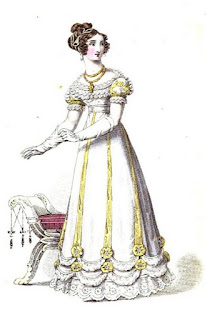This is the third article in my series of fashion blogs looking at the way spring fashions changed from 1806 to 1827. This final post on evening wear looks at the post-Regency period, from 1820 to 1827, during the reign of George IV, using fashion plates from
La Belle Assemblée from 1823 and 1827.
Spring 1823
 |
Ball dress
from La Belle Assemblée (Feb 1823) |
|
|
|
|
“This attractive and elegant dress is of tulle over white satin; the tulle ornamented with broad stripes, laid on of amber coloured satin, till they reach a double festoon ornament, in two rows of puckered tulle
en rouleaux, the points of which are headed by large rosettes of pearls; under these festoons, terminating at the hem, is a flounce of broad blond, of a rich and striking pattern. The corsage is made plain, but is trimmed round the bosom with a broad falling tucker of blond, which, from each shoulder, falls as a
mancheron ornament over the sleeve, and has a very beautiful effect...The dress is confined round the waist by a white satin ribbon sash, richly striped.”
“En rouleaux” means in rolls.
I have had some trouble deciphering “mancheron”. The first translation I found was handlebars and this did not seem very appropriate! However, “manche” means sleeve and I found a reference to “mancheron” meaning a small, short sleeve or an ornamental trimming on the upper part of a sleeve.
 |
Ball dress
from La Belle Assemblée (Mar 1823) |
“Round dress of amber coloured crape, a puckering of gauze of the same colour at the border, finished by
rouleaux, wadded very full of white satin, with full blown white roses, and a few leaves of green foliage: under each rose is an antique ornament of the
rosace kind, composed of white satin, with a tuft of amber in the interior. The body of this beautiful dress is of satin, and is elegantly diversified by white silk cordon and fine blond: the front of the bust is finished by a marrow falling tucker of blond, and the shoulders ornamented by bows of white satin ribbon. The sleeves are white, and are trimmed to correspond with the skirt, except that the flowers are left out, as an inappropriate and troublesome trimming to that part of the dress; they are, therefore, finished by the
rouleaux in points, with the
rosaces in the centre of the sleeve, encircling the arm…Shoes of white satin, and white kid gloves.”
"Rosace" means rosette.
Spring 1827
 |
Ball dress
from La Belle Assemblée (Jan 1827) |
“Over a slip of amber-coloured satin, a dress of tulle, the border, with two rows of amber gauze,
bouillonnés; the bouillon placed on the border, in close
fers de cheval, and forming a rich and striking sort of trimming. The body is
à la Circassienne, with a broad sash of amber-coloured satin; a small rosette on the left side, in the centre of which is a pearl ornament: long ends, edged round with narrow blond of a Vankdyke pattern, descend somewhat lower than the knee. The sleeves are short and full, of amber satin, trimmed with blond, and finished sown the outside of the arm with silk buttons.”
“Bouillonnés” means ruffled or puffed.
“Fers de cheval” means horseshoes.
My observations
These dresses show a distinct move away from the flowing designs of the Regency, with close-fitting bodices above narrow waistlines, which have dropped to a more natural position by 1827. The sleeves are short and puffy and the skirts are fuller and show a lot more ornamentation than those of the previous decade. It is interesting to note that all three of these dresses are yellow, or amber per the description. Clearly opinions had changed since 1806 when, in the very first issue of La Belle Assemblée, the following was written:
“The pale yellow colour, which is extremely elegant in the day for beautiful women, appears soiled in the evening, and tends very much to diminish the glow, and impair the brilliancy of the complexion.”
Sources used include:
Bell, John,
La Belle Assemblée, various (1806 -1827)




No comments:
Post a Comment